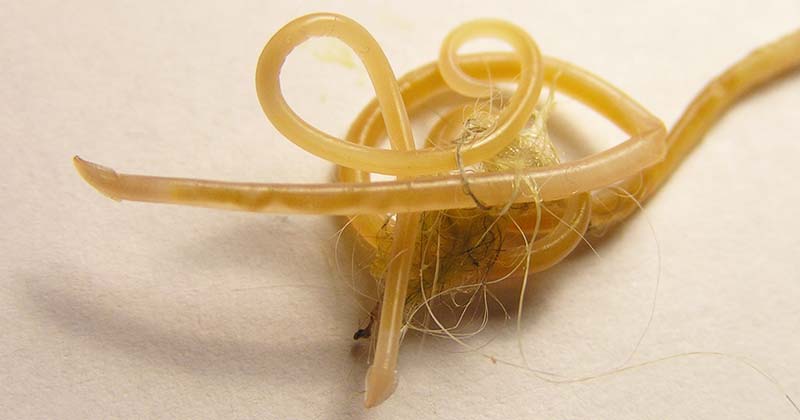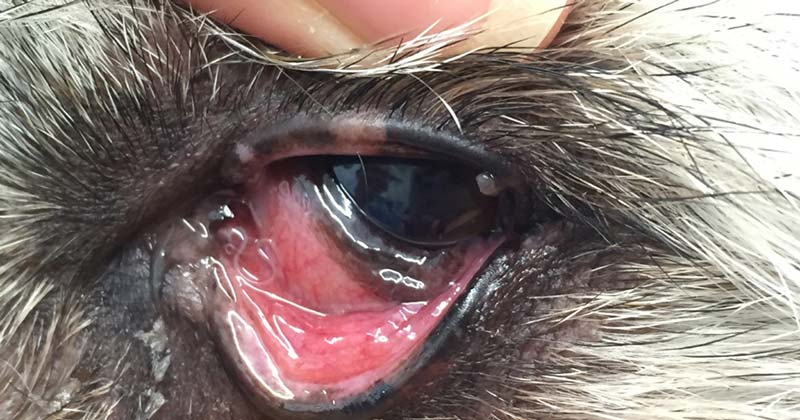3 Jul 2020
Worming protocols: key messages for pet owners

Protoscolex of Echinococcus granulosus from hyatid cyst.
Worming is something even the best of us can become complacent about – when, in fact, worms can affect so many around us.
Explaining the importance of worms to new and existing clients is critical for them to understand why they are giving their pet a medication in a world where people are questioning what they are putting in/on their pet’s body more and more.
Effect on humans
Regarding the effect worms have on humans, ask questions such as:
- Does your pet sleep on/in your bed?
- Does it sleep on the sofa where you sit?
- Do you have children or grandchildren who live with you or visit your home?
- Does your pet come into contact with people who are immunodeficient or immunocompromised, such as having chemotherapy?
- Does your cat go to the toilet in other people’s gardens?
These kind of questions can make owners realise just how many people are affected, and the fact that an animal is shedding worm eggs, which they groom from their anal area and spread across their coat – which, of course, people stroke and kiss. This could lead to them ingesting the larval stage of Echinococcus granulosus and becoming infected with hydatid disease.
Cats notoriously like using other people’s gardens to defecate in, including sandpits where children are likely to play. It is not known exactly how many people each year catch toxocariasis, which can cause temporary – or, at worst, permanent – sight issues.
Clients need to think about the full extent of how their pet could affect other people.
It is always good to remind people – especially pregnant women and those who are immunocompromised – to wash their hands thoroughly or wear gloves while/after changing or cleaning out litter trays and picking up dog faeces.
Effect on farm animals
It stands to reason that if people are not aware of the effects their deworming habits have on themselves and other humans then they will not have thought about other animals. Dogs defecating off the path in fields or spaces is frequently not thought about and faeces not picked up.
Several cases have occurred this year alone of young livestock having lost their lives after their parents ingested infected grass in their living space. This is not good enough and means clients have failed on two counts by not worming their pets appropriately, and then not picking up their faeces. Most clients would hopefully not do this in future if they realised their actions had such consequences and could potentially cause other animals to lose their lives.
Livestock intended for consumption can also be affected. In 2015, 57,500 sheep carcases were destroyed due to Cysticercus ovis. Also, 548,000 sheep livers were rejected due to Cysticercus tenuicollis in 2015 (Agriculture and Horticulture Development Board Beef and Lamb, 2015).

Effect on pets
In the UK we mostly see the following worms:
- Toxocara cati
- Toxocara canis
- Toxascaris leonina
- E granulosus
- Dipylidium caninum
- Taenia ovis
- Taenia hydatigena
- Angiostrongylus vasorum
These all carry various risks – and finding out about each patient’s lifestyle, alongside the risk factor with who they come into contain with, will help determine what worming regime is going to be best to protect everyone.
Toxocara species
Kittens and puppies are most likely to infect others. Puppies should start to be wormed from two weeks of age, and this should be repeated every two weeks, including two weeks after they have been weaned, and then monthly from then on. This is to prevent the Toxocara ova from forming in the intestines due to transplacental and transmammary infections.
Ideally, puppies would be wormed against this worm every month, which is quite easy to do when it is included in a monthly flea treatment.
The same applies for kittens, except they have their first dose at three weeks of age due to no occurrence of transplacental transmission (European Scientific Counsel Companion Animal Parasites [ESCCAP], 2017).
Worming monthly should be carried out – especially on pets whose owners have young children or immunocompromised people that they come into contact with. This is also important for animals fed unprocessed raw diets.
Worming monthly will reduce egg output by more than 90% – this may not be necessary for every animal, but this would depend on an animal’s lifestyle, such as that already mentioned, but not forgetting those cats that are hunters, which are naturally more at risk. For indoor cats, of which an increasing amount seems to exist, it is recommended they are treated at least four times a year (ESCCAP, 2017).
To reduce transmission, pregnant bitches should be given macrocyclic lactones on the 40th and 55th day of pregnancy. Alternatively, fenbendazole can be given every day from day 40 of pregnancy until 2 days postpartum (ESCCAP, 2020).

Taenia species and E granulosus
Controlling Taenia species and E granulosus is especially important due to their zoonotic nature and for livestock, too.
For dogs that live outside of E granulosus hotspots, treating them quarterly should be an absolute minimum. The areas where this worm is prevalent are the Western Isles of Scotland, mid-Wales, the Welsh border and Herefordshire.
Dogs living in these areas or visiting them frequently are considered to be at high risk – especially if they’re exposed to ruminant carcases, fed unprocessed raw meats or offal. High-risk cases should be wormed with an appropriate anthelmintic at least every six weeks. E granulosus cysts have been found in abattoirs around Britain, distributed from Wales (ESCCAP, 2017).
With Taenia species infections being spread to sheep via infected dog faeces being ingested, making sure owners are aware is important. Monthly tapeworm worming is recommended in dogs that have access to ruminant carcases or are, again, fed an unprocessed raw food diet or offal. This reduces proglottid shedding, making it safer for humans to interact safely with their pets. (ESCCAP, 2017a).
Taenia species infection in cats is considered lower risk as it is not zoonotic – it rarely causes issues to the cats unless they are avid hunters and have a heavy burden. Cats that are known hunters should be wormed monthly to keep on top of potential infections. Cats that are not known to hunt, but still go outside, should be wormed quarterly, and cats that are entirely indoors should not need treating for tapeworm (ESCCAP, 2017).
A vasorum
A vasorum is certainly a scary worm, for those of us who have had dealings with this parasite, although some areas of the UK seem to remain case‑free. Cases are being logged by various sites (such as lungworm.com) to try to draw a picture as to how prevalent it is in certain areas.
For owners who purchase flea treatment, but are not asking for wormers to also be prescribed, it is always worth asking “How are you preventing lungworm?”, rather than “Would you also like some wormer?”. It gives you the potential to educate them about lungworm and its seriousness.
Monthly worming is the only prevention, and finding out more about the dog’s lifestyle can help, too, asking owners if dogs are interested in picking up and/or eating slugs and snails. These kinds of regime questions can help you gather a better understanding of how at risk the dogs are, as well as what area they are in.
Patients that have not been treated monthly and are in high-risk areas may prompt you to carry out a lungworm blood test before any surgery; having seen cases of dogs that are haemorrhaging due to this will certainly make one more keen to ask owners about this (ESCCAP, 2017).
This brings us on to more unusual worms – worms that, thankfully, we do not see very often in the UK, but may be seen more in time as people take their pets abroad. These include:
- whipworm (Trichuris vulpis)
- hookworm (Ancylostoma species and Uncinaria species)
- eyeworm (Thelazia californiensis)
Thankfully, they are rare, but it is always good to be aware of them.

Take-home message
The take-home message is really to ask lots of questions and find out as much information as you can to make sure you are putting your patients on the best worming regime to protect everyone.
Getting gruesome is a great way to get owners to understand how serious worms can be, and to encourage them to worm responsibly.
Clients need to know why they are doing something or paying for something. You may find some clients start to lapse in giving worm treatment – perhaps you see they were given six months worth of flea and worming treatment, but are only requesting the flea treatment. Always be confident in asking them why.
Even if your clients themselves are worming their pets, others may not be. A study on washing pets’ paws and owners’ shoes on return found that 19.4% of dogs’ paws – and 11.4% of people’s shoes – had Toxocara eggs detected on them (Panova and Khrustalev, 2018).
